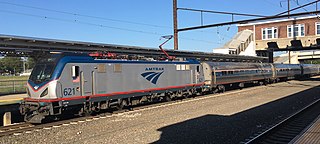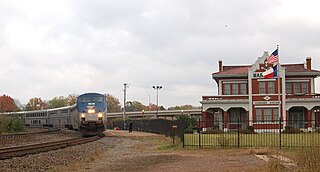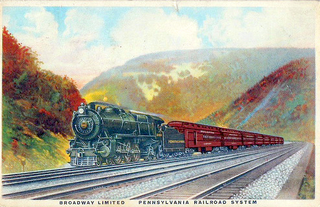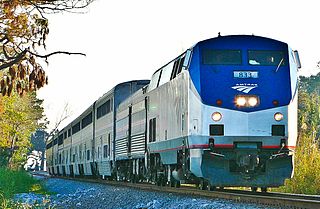
The Penn Central Transportation Company, commonly abbreviated to Penn Central, was an American class I railroad that operated from 1968 until 1976. Penn Central was a combination of three railroads: the Pennsylvania Railroad (PRR), New York Central Railroad (NYC) and the New York, New Haven and Hartford Railroad (NH). The New York, New Haven and Hartford was merged into Penn Central in 1969.

The New York Central Railroad was a railroad primarily operating in the Great Lakes and Mid-Atlantic regions of the United States. The railroad primarily connected greater New York and Boston in the east with Chicago and St. Louis in the Midwest along with the intermediate cities of Albany, Buffalo, Cleveland, Cincinnati, Detroit, and Syracuse. New York Central was headquartered in New York City's New York Central Building, adjacent to its largest station, Grand Central Terminal.

Amtrak's 195-mile (314 km) Keystone Service provides frequent regional passenger train service between the Harrisburg Transportation Center in Harrisburg, Pennsylvania and 30th Street Station in Philadelphia, running along the Philadelphia to Harrisburg Main Line. Most trains continue along the Northeast Corridor (NEC) to Pennsylvania Station in New York.

The Pennsylvanian is a 444-mile (715 km) daily daytime Amtrak train running between New York and Pittsburgh via Philadelphia. The trains travel across the Appalachian Mountains, through Pennsylvania's capital Harrisburg, the Pennsylvania Dutch Country, suburban and central Philadelphia, and New Jersey en route to New York. The entire train ride takes about 9 hours total, with 1.5 hours between New York and Philadelphia, 2 hours between Philadelphia and Harrisburg, and 5.5 hours between Harrisburg and Pittsburgh.

The Lake Shore Limited is an overnight Amtrak intercity passenger train service between Chicago and the Northeastern United States. At Albany–Rensselaer station, it divides, with separate sections serving New York City and Boston. The train uses the former main line of the New York Central Railroad, part of which is now the Empire Corridor. Amtrak began service in 1975; its Lake Shore service had operated over the same route in 1971–72. The train is named for the New York Central's Lake Shore Limited, which was discontinued in 1956.

The Texas Eagle is a 1,306-mile (2,102 km) passenger train route operated by Amtrak in the central and western United States. Trains run daily between Chicago, Illinois, and San Antonio, Texas; the service operates as a section of the Sunset Limited. The westbound Texas Eagle joins with the westbound Sunset Limited in San Antonio and continues to Los Angeles, California; the eastbound Texas Eagle splits in San Antonio for the journey to Chicago. When combined with the Sunset Limited, the Texas Eagle runs for a total of 2,728 miles (4,390 km), the longest route in the Amtrak system. Prior to 1988, the train was known as the Eagle.

The Crescent is a thrice-weekly long-distance passenger train operated by Amtrak in the eastern United States. It operates 1,377 miles (2,216 km) daily between Pennsylvania Station in New York City and Union Passenger Terminal in New Orleans as train numbers 19 and 20. Major service stops outside the Northeast Corridor include Birmingham, Ala.; Atlanta, Ga.; and Charlotte, N.C.. Daily service resumes May 24, 2021.

The Broadway Limited was a passenger train operated by the Pennsylvania Railroad (PRR) between New York City and Chicago. It operated from 1912 to 1995. It was the Pennsylvania's premier train, competing directly with the New York Central Railroad's 20th Century Limited. The Broadway Limited continued operating after the formation of Penn Central (PC) in February 1968, one of the few long-distance trains to do so. PC conveyed the train to Amtrak in 1971, who operated it until 1995. The train's name referred not to Broadway in Manhattan, but rather to the "broad way" of PRR's four-track right-of-way along the majority of its route.

The Cardinal is a thrice-weekly long distance passenger train operated by Amtrak between New York Penn Station and Chicago Union Station, with major intermediate stops at Philadelphia, Washington, D.C., Charlottesville, Charleston, Huntington, Cincinnati, and Indianapolis. It is one of three trains linking the Northeast to Chicago, the others being the Capitol Limited and Lake Shore Limited.

The Sunset Limited is an Amtrak passenger train that for most of its history has run between New Orleans and Los Angeles, over the nation's second transcontinental route. However, up until Hurricane Katrina in 2005, it ran between Orlando and Los Angeles, and from 1993 to 1996, continued on to Miami. It is the oldest named train in the United States, introduced in 1894 by the Southern Pacific Railroad, and acquired by Amtrak upon its formation in 1971.

The Sunshine Special was inaugurated by the St. Louis, Iron Mountain and Southern Railway,, on December 5, 1915, to provide a premium level of passenger train service between St. Louis, Little Rock, and destinations in Texas, such as El Paso, San Antonio, Laredo and Houston. An auxiliary section of the train originated in Memphis, Tennessee and linked with the train in Little Rock, Arkansas.

The National Limited was the premier train of the Baltimore and Ohio Railroad (B&O) on its route between New York City and St. Louis, Missouri, with major station stops in Washington, D.C., and Cincinnati, Ohio. It operated from 1925 to 1971. For much of its life it offered exclusive all-Pullman service, and it was the first long-distance train to be entirely air-conditioned. The National Limited was one of many trains discontinued when Amtrak began operations in 1971. Amtrak revived the name for another New York–St. Louis service which did not use the B&O route.
The Cincinnati Limited was a named train of the Pennsylvania Railroad; the train traveled from New York City's Pennsylvania Station to the Cincinnati Union Terminal. It was a rival to New York Central's Ohio State Limited. The Cincinnati Limited carried connecting sleeping cars to the Louisville and Nashville Railroad's Cincinnati to New Orleans Pan American. By the mid-1950s, the sleeper extension on L&N lines ended at Memphis instead of New Orleans.

The New England States was a passenger train operated by the New York Central Railroad and its successor Penn Central over the Water Level Route between Chicago and Boston. It was launched in 1938 in tandem with the relaunch of the 20th Century Limited and assumed responsibility for that train's Boston sleepers. In 1949 it became the first Chicago–Boston streamliner. The New York Central dropped the name in 1967; an unnamed remnant continued running until 1971. Amtrak's Lake Shore Limited now serves the route.

The Texas Eagle was an American streamlined passenger train operated by the Missouri Pacific Railroad and the Texas and Pacific Railway between St. Louis, Missouri, and multiple destinations in the state of Texas. It operated from 1948 to 1971. The Texas Eagle was one of many trains discontinued when Amtrak began operations in 1971, although Amtrak would revive service over the Missouri Pacific with the Inter-American in 1974. This train was renamed the Eagle in 1981 and finally the Texas Eagle in 1988.

The Ohio State Limited was a named passenger train operated by the New York Central Railroad (NYC) between New York City and Cincinnati, Ohio, via Buffalo and Cleveland, Ohio. Service began in 1924 and continued until 1967, with some vestiges remaining until 1971.

The Dixie Flyer was a premier named passenger train that operated from 1892 to 1965 via the "Dixie Route" from Chicago and St. Louis via Evansville, Nashville, and Atlanta to Florida. However, the train persisted to 1969 as an Atlanta to Florida operation, solely run by the Atlantic Coast Line Railroad and its successor. The Flyer's route varied in early years, but by about 1920 was set as follows:
The Southwestern Limited was a night train, as #205 of the Illinois Central Railroad in the Southeastern United States. Running on the IC subsidiary Yazoo and Mississippi Valley Railroad Vicksburg Division, from Meridian, Mississippi's Union Station to Shreveport, Louisiana, it was one of the few trains spanning the Mississippi River south of St. Louis, Missouri and north of New Orleans, Louisiana.

The Southwestern Limited was a passenger train service operated by the New York Central Railroad between New York City and St. Louis, from 1889 to 1966. The Southwestern Limited was one of the New York Central's luxury passenger trains. This passenger train competed with the other major railroad in the northeast, the Pennsylvania Railroad and its Blue Ribbon named passenger trains the St. Louisan, the Jeffersonian, the Penn Texas, and the Spirit of St. Louis.
The Buffalo Day Express was a long-distance north–south Pennsylvania Railroad passenger train from Washington, D.C. to Buffalo, New York. It had a second branch that originated in Philadelphia, Pennsylvania, and at times, from New York, New York. In the southbound direction, the train ran by the name, Washington Express. It was the longest running of trains on the Washington-Buffalo route, north through central Pennsylvania on the Buffalo Line, operating from 1900 to the latter years of the 1960s, with a shortened segment until 1971.















